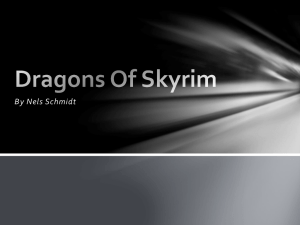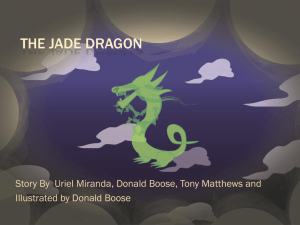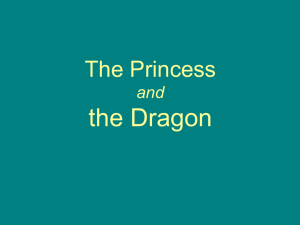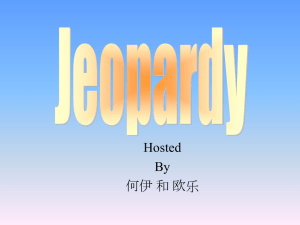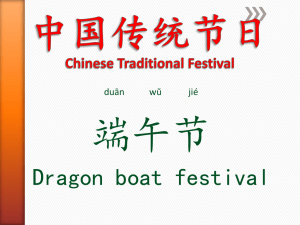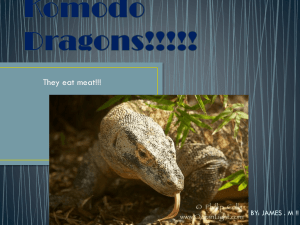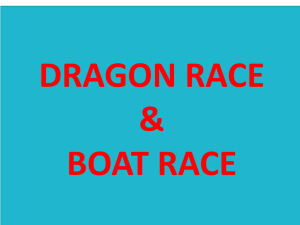Topic 10. Chinese Dragon Culture
advertisement
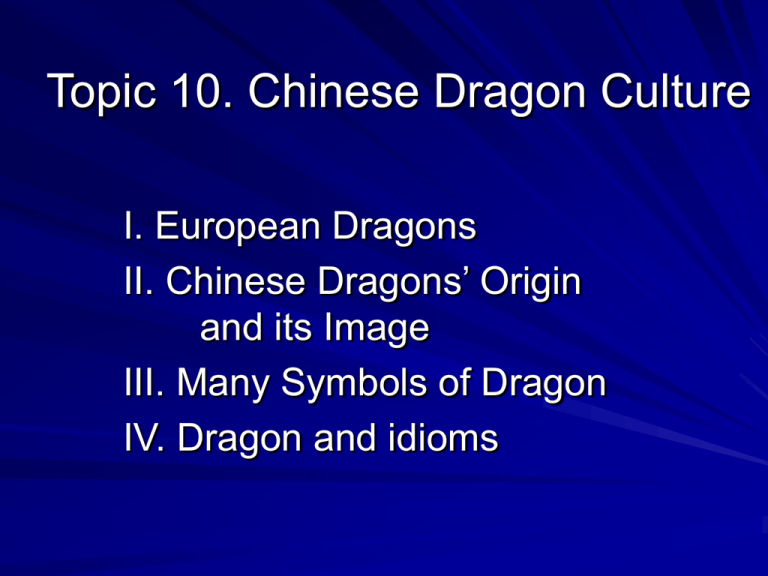
Topic 10. Chinese Dragon Culture I. European Dragons II. Chinese Dragons’ Origin and its Image III. Many Symbols of Dragon IV. Dragon and idioms I. European Dragons European dragons – They are legendary creatures in folklore and mythology – Two implications Dragon is usually portrayed as evil in many countries – Aggrasive and warlike In some countries it is portrayed as hero – It is National symbol of Wels It is part of the national flag – It is seen as a protector of Slovenia Features of European dragons – Many modern stories represent dragons as extremely intelligent creatures They can talk, associated with powerful magic. – In the modern period the dragon is typically depicted as a huge fire-breathing, scaly and horned dinosaur-like creature, with two big wings, four legs and a long muscular tail II. Chinese Dragons’ Origin and its Image Origin of the concept of dragon – Chinese dragons are legendary creatures in Chinese mythology and folklore – History It originated with the Yellow Emperor( 2696 - 2598 BC) Some scholars believe that it originated from totems of different tribes in China It was imagened as a giant with super-natural force – Ancient people did not understand thunders, bolts, floods, storms and tsunamis – It was thought the natural phenomenon were controlled by dragons The C-shaped jade dragon of Hongshan Culture – It was unearthed in Liaoning, China – It dated from about 4700 BC to 2900 BC – Earliest totem Changes of the shape of dragon Shape of dragon – Dragon is composed of parts from some animals: the horns of a deer; The mouth of a alligator the body of a snake; the scales of a fish; the claws of an eagle; the ears of an ox. III. Many Symbols of Chinese Dragon Symbol of strong force – Ruler of weather and sea water Many natural phenomenon were controlled by dragon Thunders, bolts, floods, storms and tsunamis – According to mythologic story, it is called the kings of the sea dragons (海龙王) There were four 海龙王 – – – – 东海龙王 西海龙王 南海龙王 北海龙王 They lived in the dragon palaces under oceans They were worshiped by the people to beg rain fall, stop floods, etc Symbol of power and authority – Chinese emperors thought they were the real dragons and the sons of the heaven(真龙天 子) – Dragon bed龙床 – Dragon chair龙椅 – Dragon robe龙袍 – Dragon body 龙体; “龙体欠安” – Dragon son 龙子 – Also dragons can be seen on the buildings in the imperial palace. Symbol of Chinese nation – All people in China, including the emperor, prostrated themselves before the image of a dragon with reverence and awe. – This unreal animal became the spiritual sustenance – Dragon is symbol of China “世界的东方有一条龙,它的名字叫中国” – Dragon on the national flag of the last feudal dynasty, the Qing Dynasty. – The dragon is always used in the West as a national symbol of China Talking about two Asian powers, China and India rising up, it is always maintioned that dragon and elephant are competing – Officially this usage is not common in China. – In European-influenced cultures, the dragon has aggressive and warlike implication Chinese government avoid using it as a symbol of China – West media use it in both goodwill and illintention “Descendants of the dragon” (龙的传人) – It is the same as “ descendants of Yan and Huang” (炎黄子孙) – The earliest Emperors Yan Di and Huang Di were closely related to dragon The first legendary Emperor, Huang Di, was said to have been immortalized into a dragon that went to Heaven. The other legendary Emperor, Yan Di was born by his mother's telepathy with a mythic dragon. So the Chinese consider Huang Di and Yan Di as their ancestors, "the descendants of the dragon". Auspicious symbol – Some Chinese mascots Magpie – Bring good news to you Chinese unicorn – The Chinese unicorn is named as Qilin(麒麟) too. The Chinese unicorn is a lucky supernatural animal in China’s ancient legend. – It symbolizes peace and longevity in China. Redcrowned crane – It is the symbol of long life. The people often paint redcrowned crane and tall pine together in China. Lion – The lion is the most common in the Chinese lucky pattern. – There are often two stone lions in front of the gate of palace and local authorities. – The male lion is on the left, the female lion is on the right. The male lion symbolizes the power; the female lion symbolizes future generations prosperously. Pi Xiu – It bring the wealth to you. and it will protect its master wholeheartedly – It can counteract evil force and bring the wealth and good luck to its master. – It has the mouth, but no the anus. It regards jewel, gold and silver as food. it only eats money, and does not excrete. – So the businessman often puts Pi Xiu in the company or home in China. It is said the richest man Li Jiacheng (李嘉诚)in Hong Kong has 888 Pi Xiu. Dragon and phoenix (凤凰) – Dragon and phoenix is the auspicious animal in the Chinese legend. – They symbolize auspicious, joyous and noble. – The dragon and phoenix pattern is generally used in the Chinese wedding celebration. – Both bridegroom and bride happy 龙凤呈祥 – Dragon symbolizes male; Phoenix symbolizes female – They symbolize couple harmoniously, the marriage is happy. – Son in law 乘龙快婿 – Pregnant with son and daughter 龙凤胎 – Dragon Year: auspicious Symbol of ability and success – 望子成龙 – 北大一条虫,出去一条龙 Dragon vs. worm 虫 IV. Nine Dragons Wall(九龙壁) There are three nine-dragon walls in China – The biggest and oldest one, located in Datong, Shanxi It was built in Liao Kingdom (916~1125 A.D); – The most sophisticated and beautiful one is the one in the Beihai (North Sea) Park in Beijing; – The third one is in front of the Ningyong Gate in the Forbidden City Shape of the dragons – Each dragon is playing with a unique jewelry ball. – The dragons were painted in different colors with three dimension, and were handcrafted with the highest level of workmanship. The Nine Dragon Wall in Bei Hai Park – After hundreds of years the colors of the ceramic tiles remain brilliant. The wall was built in 1756. It is 21m long, about 15m high and 1.2m thick. It is faced with 424 7-color ceramic tiles. – There is a giant dragon at the center of the wall It is flanked by four dragons on each side. In addition to these nine large dragons, the wall is covered from edge to edge with many smaller dragons. There are 635 dragons in all. V. Dragon in Traditional Festivals The dragon also plays an important part in Chinese festivals, especially in Chinese N.Y. The Dragon Dance – itself originated during the Han Dynasty and was started by the Chinese who had shown great belief and respect towards the dragon. – It is believed to have begun as part of the farming and harvest culture, also with origins as a method of healing and preventing sickness. – It was already a popular event during the Song Dynasty It had become a folk activity and like the lion dance, was most often seen in festive celebrations – Dragon Dance has spread throughout China and to the whole world. It becomes a special performance of arts in the Chinese physical activities. It symbolizes the bringing of good luck and prosperity in the year to come. In the Qing Dynasty, the Dragon Dance team of the province of Foochow had been invited to perform in Peking and had been greatly praised and admired by the Qing Emperor, which earned great fame for the team Since then, dragon dance was getting more and more popular The dragon dance is a highlight of Chinese New Year celebrations It was held worldwide in Chinatowns around the world. – The Dragon Boat Festival龙舟节 This festival is celebrated on 5th of fifth lunar month It is also called Duanwu Festival 端午节 The Chinese Dragon Boat Festival is a significant holiday celebrated in China It has a longest history. The Dragon Boat Festival is celebrated by boat races in the shape of dragons. – Competing teams row their boats forward with a drumbeat, racing to reach the finish end It is almost purely dragon-related festival, which becomes popular international events now. The boating is traditional custom to attempt to commemorate patriotic poet Qu Yuan (屈原) – He drowned on the fifth day of the fifth lunar month in 277 B.C. – When people were seeing his drowning, they rowed boats to rescue he – Later, on this day every year, dragon race was held – Chinese citizens now throw bamboo leaves filled with cooked rice into the water so that the fish could eat the rice rather than Qu Yuan’s body. – Today, to celebrate this festival, there are three things to do Dragon boat race Eat 粽子 Qu Yuan – It served as minister to the Chou Emperor during the Warring State period. – He did much to fight against political corruption in the court-- thereby earning the envy and fear of other officials – Therefore, when he urged the emperor to avoid conflict with the Qin Kingdom, the officials pressured the Emperor to have him removed from service. – In exile, he traveled, taught and wrote for several years – Hearing that the Zhou had been defeated by the Qin, he fell into despair and threw himself into a River. VI. Dragon and idioms 叶公好龙 – “Lord Ye's Love of Dragons” or “Mr. Ye loves dragon” – It means that somebody would not really like something, but he orally always says he like it very, very much. – Lord Ye says he loves dragons deeply. He had dragons everywhere in his home. He drew dragons on walls, sculptured dragons on pillars, put dragons on tables and everywhere He was thinking of dragons all the time. – One day, his love of dragons moved a real dragon, so the dragon came to visit him. – When he saw the real dragon, he was frightened to death. 龙飞凤舞 – It is to describe somebody’s Chinese calligraphy. Two meanings Caoshu (草书): praise Kaishu (楷书): criticize or satirize 龙腾虎跃 – Describe a occasion or a scene very active – 腾、跃:move, act and jump up and down quickly like dragon and phoenix 生龙活虎 – Similar to above – Describe persons with active energy “四小龙”、“四小虎” Dragons in Thai social life?

